Heavy-lift launch vehicle
A heavy-lift launch vehicle, HLV or HLLV, is an orbital launch vehicle capable of lifting between 20,000 to 50,000 kg (44,000 to 110,000 lb) into low Earth orbit (LEO).[1] As of 2019, operational heavy-lift launch vehicles include the Ariane 5, the Long March 5, the Proton-M and the Delta IV Heavy.[2] In addition, the Angara A5, the Falcon 9 Full Thrust, and the Falcon Heavy are designed to provide heavy-lift capabilities in at least some configurations but have not yet been proven to carry a 20-tonne payload into LEO. Several other heavy-lift rockets are in development. An HLV is between medium-lift launch vehicles and super heavy-lift launch vehicles.
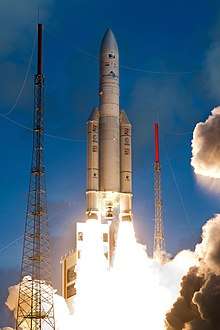
Rated launch vehicles
| Rocket | In service | Manufacturer | Max. LEO payload | Launches >20 t | Heaviest launch | ||
|---|---|---|---|---|---|---|---|
| ...to LEO or MEO | ...to GTO or GSO | ...to HEO and beyond | |||||
OperationalCurrently operational rockets that have demonstrated their heavy-lift capability to low Earth orbit: | |||||||
| Ariane 5 (ECA and ES) |
since 2002 | Airbus for ESA | 21,000 kg (46,000 lb)[3] |
4 | 20,293 kg[4] Georges Lemaître ATV 29 July 2014 |
10,865 kg[5] ViaSat-2 and Eutelsat 172B 1 June 2017 |
~6,000 kg to Sun-Earth L2[6] Herschel and Planck 14 May 2009 |
| Delta IV Heavy | since 2004 | ULA | 28,790 kg (63,470 lb)[7] |
1 public (up to 4 classified) |
~21,000 kg[8][lower-alpha 1] Orion EFT-1 5 December 2014 |
Classified[lower-alpha 2] | ~685 kg to heliocentric Parker Solar Probe |
| Long March 5 (CZ-5B) |
since 2016 | CALT | 25,000 kg (55,000 lb)[9] |
1 | 21,600 kg[10] LM5B-Y1 5 May 2020[11] |
8,000 kg[12] Shijian 20 27 December 2019 |
5,000 kg to Mars[13] Tianwen-1 23 July 2020 |
UnprovenRockets that have not flown a 20-tonne payload to LEO, but are rated over this threshold: | |||||||
| Proton-M | since 2001 | Khrunichev | 23,000 kg (51,000 lb)[14] |
0 | N/A (22,776 kg by predecessor Proton-K) |
6,740 kg[15] ViaSat-1 19 October 2011 |
3,755 kg to Mars[16] ExoMars TGO 9 June 2016 |
| Angara A5 | since 2014 | Khrunichev | 24,500 kg (54,000 lb)[17] |
0 | N/A | 2,000 kg[18] Mass simulator 23 December 2014 |
N/A |
| Falcon 9 Full Thrust (expendable configuration)[lower-alpha 3] |
since 2015 | SpaceX | 22,800 kg (50,300 lb)[19] |
0 | 9,600 kg[20] Iridium NEXT-5 30 March 2018 (15,600 kg[21] by partially reusable configuration Falcon 9) |
6,761 kg[22] Intelsat 35e 5 July 2017 (7,075 kg[23] by partially reusable configuration Falcon 9) |
570 kg to Sun-Earth L1[24] DSCOVR 11 February 2015 |
| Falcon Heavy (with all boosters reusable)[lower-alpha 4] |
since 2018 | SpaceX | 38,000–45,000 kg (84,000–99,000 lb) [25][26] |
0 | 3,700 kg[27][lower-alpha 5] STP-2 25 June 2019 |
6,465 kg[28][lower-alpha 6] Arabsat-6A 11 April 2019 |
1,300 kg beyond Mars[29] Tesla Roadster 6 February 2018 |
RetiredFormerly operational rockets with a payload capacity of between 20 and 50 tonnes: | |||||||
| Saturn IB | 1966 to 1975 | Chrysler (S-IB), Douglas (S-IVB) | 21,000 kg (46,000 lb)[30] |
2 | 20,847 kg Skylab 4 16 November 1973 |
N/A | N/A |
| Proton-K | 1967 to 2012 | Khrunichev | 19,760 kg (43,560 lb)[31] |
4[32] | 22,776 kg Zvezda 26 July 2000 |
4,723 kg Intelsat 903 30 March 2002 |
6,220 kg to Mars Phobos 1 7 July 1988 |
| Space Shuttle | 1981 to 2011 | United Space Alliance | 24,400 kg (53,800 lb) (in cargo bay)[33] |
11 | 22,753 kg STS-93 28 July 1999 |
N/A | N/A |
| Titan IV | 1989 to 2005 | Lockheed Martin | 21,680 kg (47,800 lb)[34] | up to 17 (classified) | Classified[lower-alpha 2] | Classified[lower-alpha 2] | 5,712 kg to Saturn Cassini–Huygens 15 October 1997 |
In developmentRockets that are actively being developed: | |||||||
| Ariane 6 (A64) | NET 2021 [35] |
ArianeGroup for ESA | 21,650 kg (47,730 lb)[36]:46 | N/A | N/A | N/A | N/A |
| H3 Heavy | 2030 | Mitsubishi Heavy Industries for JAXA | 28,300 kg (62,400 lb)[37] | N/A | N/A | N/A | N/A |
| HLV | NET 2022 | Indian Space Research Organisation | 20,000 kg (44,000 lb) | N/A | N/A | N/A | N/A |
| SHLV | NET 2022 | Indian Space Research Organisation | 41,300 kg (91,100 lb) | N/A | N/A | N/A | N/A |
| New Glenn | 2021[38] | Blue Origin | 45,000 kg (99,000 lb)[39] | N/A | N/A | N/A | N/A |
| Vulcan / Centaur | April 2021[40] | United Launch Alliance | 25,000 kg (56,000 lb)[41] | N/A | N/A | N/A | N/A |
| Vulcan / ACES | NET 2023[42] | United Launch Alliance | 37,400 kg (82,500 lb)[7][43][lower-alpha 7] | N/A | N/A | N/A | N/A |
Earlier concepts | |||||||
| Ares I | N/A | NASA (canceled in 2010)[44] |
25,400 kg (56,000 lb) | N/A | N/A | N/A | N/A |
- The officially reported mass of 21,000 kg includes the Launch Abort System (LAS) which did not reach orbit, but excludes the residual mass of the upper stage, which did reach orbit, likely offsetting the mass of the LAS.
- Actual payloads flown are classified under the NRO launch program.
- Fairing recovery may be possible in all configurations; if the first stage is recovered, the payload capacity only fits the medium-lift launch vehicle criteria.
- When the center core is expended, Falcon Heavy is classified as a super heavy-lift launch vehicle with a theoretical payload to LEO over 50,000 kg
- The 600 kg DSX was boosted to Medium Earth Orbit
- to 90,000-km supersynchronous GTO
- Calculated as 30% more than Delta IV Heavy, per sources
Gallery
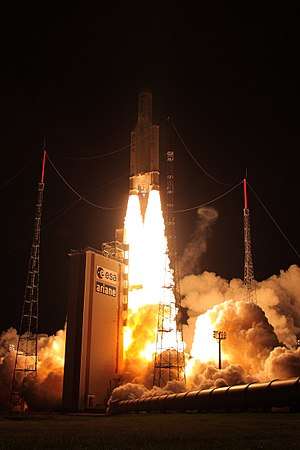
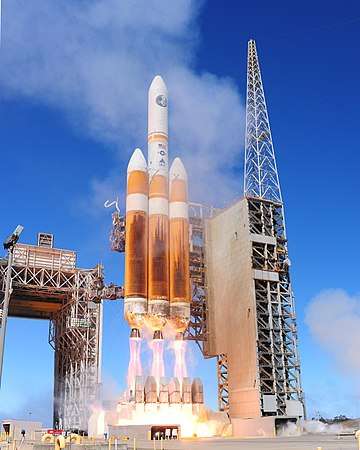 Delta IV Heavy launching a classified National Reconnaissance Office payload on 28 August 2013, from Vandenberg Air Force Base, California
Delta IV Heavy launching a classified National Reconnaissance Office payload on 28 August 2013, from Vandenberg Air Force Base, California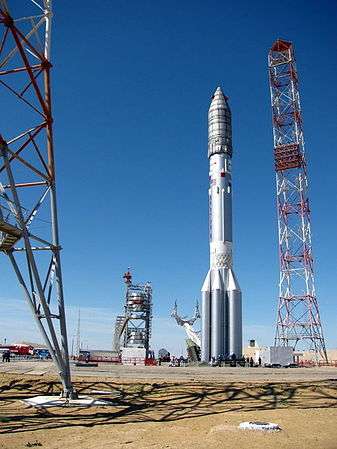 Proton-M on the launch pad at Baikonur Cosmodrome
Proton-M on the launch pad at Baikonur Cosmodrome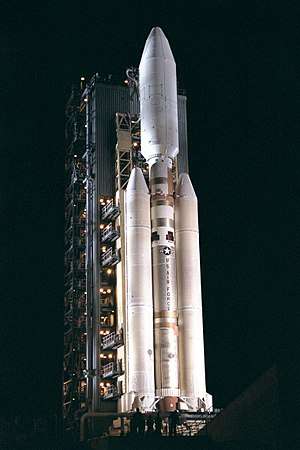 Titan IV ready to launch the Cassini–Huygens probe from Vandenberg in October 1997
Titan IV ready to launch the Cassini–Huygens probe from Vandenberg in October 1997
See also
- Comparison of orbital launch systems
- List of orbital launch systems
- Comparison of orbital rocket engines
- Comparison of space station cargo vehicles
- Medium-lift launch vehicle, capable of lifting between 2,000 and 20,000 kg (4,400 to 44,100 lb) of payload into Low Earth orbit
- Rocket
- Small-lift launch vehicle, capable of lifting up to 2,000 kg to low Earth orbit
- Sounding rocket, suborbital launch vehicle
- Spacecraft propulsion
- Super heavy-lift launch vehicle, capable of lifting more than 50,000 kg (110,000 lb) of payload into Low Earth orbit
References
- NASA Space Technology Roadmaps – Launch Propulsion Systems, p.11: "Small: 0-2t payloads, Medium: 2-20t payloads, Heavy: 20-50t payloads, Super Heavy: >50t payloads"
- May, Sandra (27 August 2014). "What Is a Heavy Lift Launch Vehicle?". NASA. Retrieved 11 June 2017.
- "Ariane 5 Users Manual, Issue 4, P. 39 (ISS orbit)" (PDF). Arianespace. Archived from the original (PDF) on 27 September 2007. Retrieved 13 November 2007.
- "Lanzamiento del ATV-5 Georges Lemaître (Ariane 5 ES)".
- "Arianespace marks its 2017 mid-year launch milestone with a record-setting Ariane 5 mission at the service of ViaSat and Eutelsat" (Press release). Arianespace. 1 June 2017. Retrieved 2 June 2017.
- http://www.arianespace.com/mission-update/arianespace-launches-two-spacecraft-on-missions-to-explore-the-universe/
- "Delta IV Launch Services User's Guide, June 2013" (PDF). United Launch Alliance. June 2013. pp. 2–10. Archived from the original (PDF) on 10 July 2014. Retrieved 9 October 2017.
- "NASA Orion Exploration Flight Test-1 PRESS KIT" (PDF). NASA. December 2014. p. 12.
- "Long March 5B launch clears path for Chinese space station project". SpaceNews.com. 5 May 2020. Retrieved 5 June 2020.
- Barbosa, Rui C. (4 May 2020). "Maiden launch of Long March 5B lofts Next Generation Crew Space Capsule". nasaspaceflight.com. Retrieved 5 May 2020.
- "China's first Long March 5B rocket launches on crew capsule test flight". Spaceflightnow.com. 5 May 2020. Retrieved 5 May 2020.
- "SJ 20 – Gunter's Space Page". space.skyrocket.de. Retrieved 6 January 2020.
- "China launches ambitious attempt to land rover on Mars". nbcnews.com/. 23 July 2020. Retrieved 23 July 2020.
- "Proton Launch System Mission Planner's Guide – Section 2. LV Performance" (PDF). International Launch Services. July 2009. Retrieved 11 June 2017.
- Krebs, Gunter. "ViaSat 1". Gunter's Space Page. Retrieved 11 June 2017.
- "ExoMars Trace Gas Orbiter (TGO)". European Space Agency. 12 July 2012. Retrieved 8 March 2014.
- "Spaceflight101, Angara-a5". Archived from the original on 9 August 2018. Retrieved 22 December 2015.
- "Russia made its first test launch "Angara-A5"". RIA Novosti. 23 December 2014. Retrieved 23 December 2014.
- Capabilities & Services (2016)
- de Selding, Peter B. (15 June 2016). "Iridium's SpaceX launch slowed by Vandenberg bottleneck". SpaceNews. Retrieved 11 June 2017.
Each Iridium Next satellite will weigh 860 kilograms at launch, for a total satellite payload mass of 8,600 kilograms, plus the 1,000-kilogram dispenser.
- "SpaceX and Cape Canaveral Return to Action with First Operational Starlink Mission". NASASpaceFlight.com. 1 November 2019. Retrieved 11 November 2019.
- Graham, William (3 July 2017). "SpaceX Falcon 9 launches with Intelsat 35e at the third attempt". NASASpaceflight.
- Krebs, Gunter. "Telstar 19V (Telstar 19 Vantage)". Gunter's Space Page. Gunter. Retrieved 7 August 2018.
- "DSCOVR: Deep Space Climate Observatory" (PDF). NOAA. January 2015. Archived from the original (PDF) on 2 April 2015. Retrieved 14 March 2015.
- Elon Musk [@elonmusk] (30 April 2016). "@elonmusk Max performance numbers are for expendable launches. Subtract 30% to 40% for reusable booster payload" (Tweet) – via Twitter.
- http://www.spacex.com/about/capabilities
- https://twitter.com/AF_SMC/status/1141099481628364808%5B%5D
- "Arabsat 6A". Gunter's Space Page. Retrieved 13 April 2019.
- "Tesla Roadster (AKA: Starman, 2018-017A)". ssd.jpl.nasa.gov. 1 March 2018. Retrieved 15 March 2018.
- Entering the Race to the Moon, Saturn IB Established Its Place in Space.
- http://www.khrunichev.ru/main.php?id=54
- http://www.spacelaunchreport.com/proton.html
- astronautix.com, Space Shuttle
- astronautix.com, Titan IV Archived 18 February 2016 at the Wayback Machine
- Clark, Stephen (13 August 2016). "Ariane 6 rocket holding to schedule for 2020 maiden flight". Spaceflight Now. Retrieved 13 August 2016.
- Lagier, Roland (March 2018). "Ariane 6 User's Manual Issue 1 Revision 0" (PDF). Arianespace. Retrieved 27 May 2018.
- https://spacenews.com/mitsubishi-heavy-industries-mulls-upgraded-h3-rocket-variants-for-lunar-missions/
- "Blue Origin resets schedule: First crew to space in 2019, first orbital launch in 2021". Geekwire. 10 October 2018. Retrieved 9 November 2018.
- Foust, Jeff (8 March 2017). "Eutelsat first customer for Blue Origin's New Glenn". SpaceNews. Retrieved 8 March 2017.
- Foust, Jeff (25 October 2018). "ULA now planning first launch of Vulcan in 2021". SpaceNews. Retrieved 11 November 2018.
- "United Launch Alliance Building Rocket of the Future with Industry-Leading Strategic Partnerships" (Press release). United Launch Alliance. 27 September 2018. Retrieved 28 September 2018.
- DeRoy, Rich S.; Reed, John G. (February 2016). "Vulcan, ACES and beyond: providing launch services for tomorrow's spacecraft" (PDF). Advances in the Astronautical Sciences. Univelt. 157: 228. AAS 16-052. Retrieved 28 September 2018.
- "Vulcan Centaur". United Launch Alliance. 2018. Retrieved 28 September 2018.
- "Constellation Is Dead, But Pieces Live On". Aviation Week, 26 October 2010.
Further reading
- Mallove, Eugene F. and Matloff, Gregory L. The Starflight Handbook: A Pioneer's Guide to Interstellar Travel, Wiley. ISBN 0-471-61912-4.
.jpg)